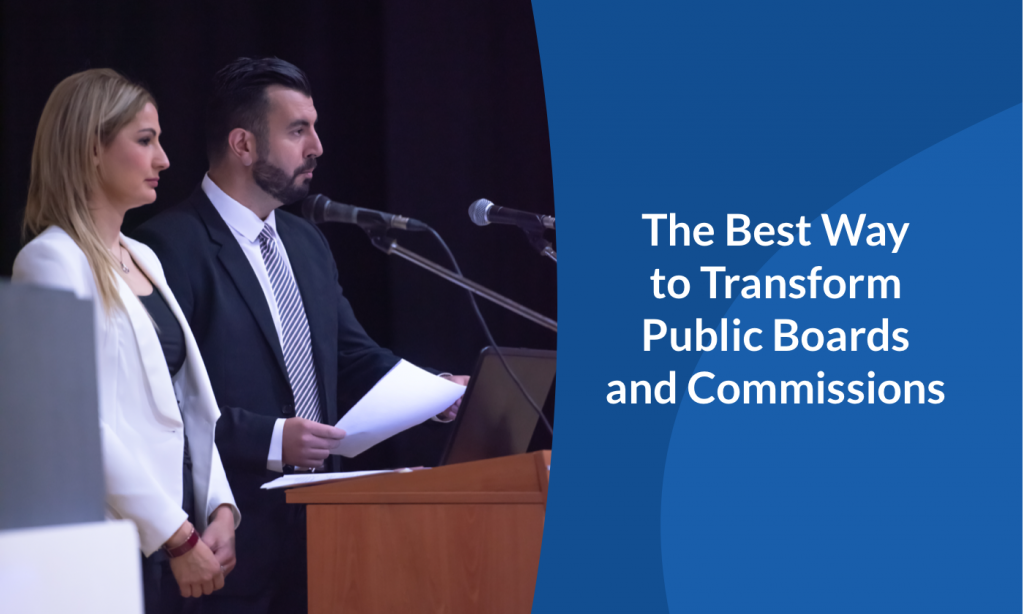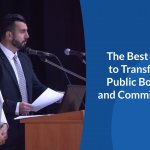
In this era of digital communications, debate over the role of technology to support engagement efforts by government boards and commissions is constant. COVID-19 has put this front and center as all levels of government are exploring how to use technology to respond to the growing public health threat and inform and share information with constituents. This post will explore how technology can support meaningful engagement and has the capability to transform public board meetings into highly effective avenues of outreach.
Boards and Commissions are the Key for Public Engagement
To fulfill its mandate of serving the public trust, a well-functioning government needs to be representative of its community, transparent, and accountable. That means sharing information about decision-making and spending—public boards and commissions are an essential vehicle to do exactly that.
Here’s why:
- Public boards and commissions are ubiquitous and exist at all levels of government.
- These institutions provide an opportunity for a range of people and perspectives to be incorporated into the governing process.
- Serving on a board or commission is significantly easier than running for elected office and exists as an important forum for citizen oversight and for public officials to receive feedback.
“Transparency” isn’t just an abstract concept; it’s the necessary precondition to effective governance. Public boards and commissions that operate openly have proven to be more successful. Not only are they able to make more informed decisions, but they have the runway to tackle big issues and try new initiatives.
The Public Sector Must be Digital By Default
Unfortunately, it’s not enough to simply rely on board members’ best intentions to operate in such a manner. There are just too many challenges and ideas competing for attention. The public sector must be proactive and create a digital strategy that encourages transparency and meaningful engagement.
The accessibility of digital information makes such efforts possible. For example, smartphones (81% according to Pew Charitable Trust) and computers (3/4 of adults) are commonplace. Sharing information with the public on these devices — the channels they’re already using and prefer — would be a powerful first step.
Bottom line: an effective partnership between government and its citizens requires a strategy that emphasizes digital communication by default.
OnBoard Can Help
The technology available today enables public boards and commissions to amplify their efforts to better engage and communicate with the public. Board management software such as OnBoard has a critical role to play here.
- Public posting, for instance, cultivates confidence and transparency by enabling boards and commissions to easily share data, documents, and presentations with citizens.
- With COVID-19 shutting down large portions of in-person public life, the move to virtual meetings will make it possible to engage citizens and allow for participation. After all, government institutions need to find creative ways to continue operations and meet critical needs amidst all the disruption while fulfilling their obligation to keep citizens informed and involved.
An effective partnership between government and its citizens requires a strategy that emphasizes digital communication by default.
True Engagement and Collaboration are Within Sight
Boards and commissions are the linchpin of representative, transparent, and accountable government. Those who serve, fulfill vital administrative and advisory roles that contribute to creating communities that are engaged and exceptional. With the right strategy and tools in place, these institutions can build collaborative partnership that transforms the public sphere into highly effective avenues of citizen-led government.
About The Author

- Director of Business Development and Government Strategy
Latest entries
 Board Management SoftwareAugust 22, 2022What is an Annual General Meeting (AGM)? (Overview, Definition, and Examples)
Board Management SoftwareAugust 22, 2022What is an Annual General Meeting (AGM)? (Overview, Definition, and Examples) Board Management SoftwareOctober 3, 2021How to Use a Board Skills Matrix
Board Management SoftwareOctober 3, 2021How to Use a Board Skills Matrix Board Management SoftwareApril 14, 2020The Best Way to Transform Public Boards and Commissions
Board Management SoftwareApril 14, 2020The Best Way to Transform Public Boards and Commissions Board Management SoftwareApril 8, 2020How to Manage a Public Meeting Remotely
Board Management SoftwareApril 8, 2020How to Manage a Public Meeting Remotely
